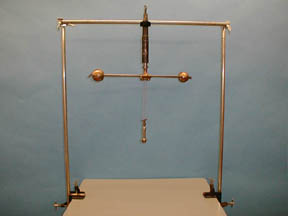Demos: 1Q-20 Conservation of Angular Momentum (Sliding Spheres)

A pair of spheres can slide without rotating on a pair of parallel bars. The bar is attached at its center to a shaft by a swivel joint about which it can rotate. A pair of strings are attached to the spheres and are brought over small pulleys below the joint. Initially the spheres are separated, and the apparatus rotated by hand. The strings are then pulled downward causing the the spheres to move quickly to the center. The rotation speeds up significantly.
Since the torques exerted by the strings about the central axis are zero, angular momentum is conserved, so we have

Directions: As suggested above, place the spheres out from the center and give the system a slow rotation (about 1 rpm or so). After it has undergone a revolution or two, grasp the holder to which the strings are attached and pull downward.
Suggestions for Presentation: This is one in a series of demonstrations showing how the angular speed changes when the rotational inertia is changed internally. In each of these, focus on the fact that the internal change occurs in the absence of an EXTERNAL torque, so that angular momentum is conserved.
Applications: As in 1Q - 23, this principle is responsible for the spinning divers and ice skaters.
Last Updated: Nov 30, 2023 11:25 AM